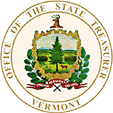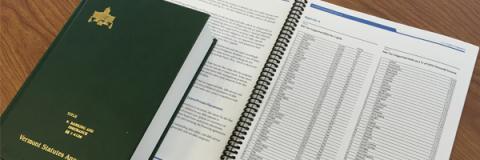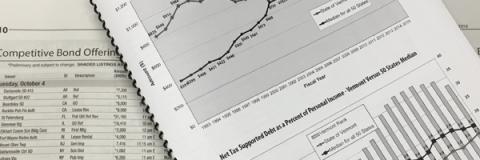Climate Infrastructure Financing Updates
December 15, 2024 Climate Infrastructure Financing Report
November Climate Finance Roundtable - 11/19/2024
The Treasurer's Office hosted its second “Climate Finance Roundtable,” convening national and local leaders from across sectors to strengthen coordination in securing and deploying federal funding for climate infrastructure and resilience projects in Vermont.
The discussion highlighted the potential implications of the 2024 election on federal funding opportunities, the critical role of resilience investments in supporting flood recovery, and innovative strategies to overcoming challenges faced by Vermont’s small towns. Speakers included state government officials and representatives from Bloomberg Philanthropies, the Government Finance Officers Association (GFOA), the Climate Action Office, USDA Rural Development, the Vermont Bond Bank, and other key organizations. The event sought to improve coordination in securing climate infrastructure funding resources and to establish a framework for cross-sector collaboration.
The 2024 election has created particular uncertainty around the future of the Inflation Reduction Act (IRA), a cornerstone of the Biden Administration's climate and energy agenda. This uncertainty for IRA programs like Elective Pay, which provides partial rebates for eligible clean energy projects upon completion, may discourage eligible entities from pursuing funding. As uncertainties around the IRA crystallize, many speakers emphasized prioritizing resilience investments to mitigate the impacts of flooding and extreme weather.
As these and other funding opportunities and programs evolve, the Treasurer’s Office will continue working to expand access to federal programs and develop innovative funding strategies to support key resilience investments statewide.
Vermont Climate Infrastructure and Resilience Federal Funding Program Matrix
Climate Finance Roundtable Survey - 06/13/2024
The goal of this form is to better understand the needs of people and organizations trying to access Federal funding for climate infrastructure financing or resilience-related investments in Vermont.
Your responses will help shape how the Treasurer’s Office focuses its attention on future coordination meetings focused on securing Federal funding. The Treasurer’s goal is to increase the total amount of funding available and to encourage those applying for these funds to make them as accessible as possible to Vermonters interested in climate infrastructure or resilience-related investments.
- Climate infrastructure financing means accessing money to build or buy something – like rooftop solar, community solar, hybrid or electric vehicles, electric vehicle charging, etc.
- Resilience-related investments are generally investments in a community or business that help it withstand major climate events like floods in the future.
2023/2024 Climate Infrastructure Financing Report - 01/16/2024
The Treasurer's Office was tasked by the Legislature to coordinate the State’s climate infrastructure financing efforts, collaborating with stakeholders to create a framework for effective collaboration among Vermont organizations, agencies, and the financial instrumentalities of the State to maximize the amount of federal Greenhouse Gas Reduction Funds the State may receive and effectively coordinate the deployment of these and other greenhouse gas reduction funds.
The Treasurer submitted recommendations to the General Assembly regarding legislation for Vermont’s climate infrastructure financing on January 15, 2024.
Request for Public Comment:
The Legislature identified a number of specific stakeholders to engage in this work. Written comments were accepted through Friday, November 3, 2023.
Topic: Why Pursue Federal Funding/Financing? How can we do this in a way that is more inclusive of local and underserved community priorities?
- How can Vermont be more effective in considering the needs of underserved or rural communities with respect to making climate infrastructure improvements, such in the areas of clean energy, weatherization or climate resiliency in Vermont? For example, investments in natural solutions for flood mitigation, sustainable agriculture and forestry, floodplain and wetland restoration and other natural resilience solutions, energy efficiency and renewable energy. Are you aware of any specific projects and programs that need to be expanded or more focused on these communities?
- How can we better connect community groups and technical expertise, to mutually identify needs?
- What do small, underserved, rural communities need to do to pursue these funds? How do we maximize our ability to do this collectively, without competing with one another?
- What do you estimate as the total investment amount required by your industry to support necessary climate infrastructure needs in Vermont? How did you arrive at this estimate? Alternatively, do you have suggestions on approaches/frameworks to estimate this need?
Topic: Who is proactively engaged and are there any barriers impeding Vermont’s efforts?
- Are you aware of any agency or entity that is pursuing or has recently pursued/applied for federal funding/financing, private capital or philanthropic funds for climate infrastructure improvements, such in the areas of clean energy, weatherization or climate resiliency? If so, what are the entities and how successful are they?
- How can we build on these efforts and unlock the door to additional capital import?
- How do we integrate various efforts so we aren’t competing for time, attention, etc.
- What are the gaps or barriers in this work?
Topic: What does Vermont need to pursue its share of federal, private or philanthropic funds to conduct climate infrastructure improvements?
- How could financing address these barriers experienced by underserved and rural communities? What other barriers exist?
- What resources (including technical assistance) does Vermont need to pursue that is currently available through federal funding/financing, private capital or philanthropic funds and be more competitive?
- What is needed to improve clean energy and resilience project identification and implementation? How would strategic planning or a focus on coordination among parties and/or financing entities support project implementation? What entities do you currently look to (can include your own) for this strategic coordination?
- Are current state agency programs and existing nongovernmental organizations in Vermont sufficient to achieve these goals or does there need to be a new governmental, quasi-governmental, or nonprofit to assist in this? What do you envision its role to be and how would it work with current state agencies and groups?





